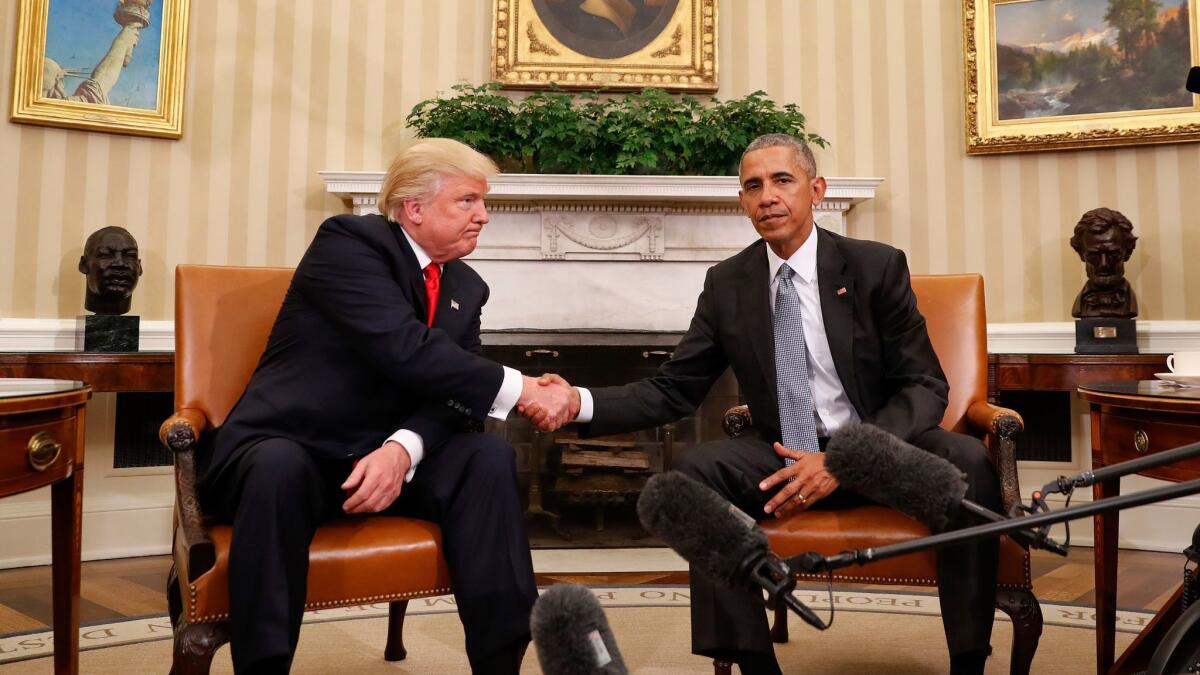Op-Ed: Obama’s diverse American majority was just an anomaly. Now what?

- Share via
Since Barack Obama’s historic win in 2008, Democrats have become increasingly enamored with the potential of solidifying a new majority coalition that his election seemed to forecast. We would ride to victory on the backs of millennials and minorities, with a few affluent suburbanites thrown in for good measure. States such as Florida, Virginia, North Carolina, Colorado and Nevada featuring growing and diverse populations and changing economies would be at the vanguard, joining with states from both coasts plus the Rust Belt to strengthen an already potent Blue Wall, guaranteeing electoral college majorities for decades to come.
It might occur one day. But Donald Trump just told any Democratic strategist who thought this was the formula for success in 2016: “You’re fired.” His stunning victories in Pennsylvania, Michigan and Wisconsin — added to relatively easy jaunts through Iowa and Ohio — exposed Obama’s coalition as simply an oasis in a political desert for Democrats. Obama won twice, but in the three other national elections since 2008, we have been crushed, losing first the House and the state houses, then the Senate and now the presidency. The common thread that runs through each defeat is a massive shift among white voters without a college degree to the GOP camp.
[Some Wisconsin voters] voted for a black man twice and a lesbian once, but because they refused to support Clinton, they are now branded racist or sexist?
Hillary Clinton and her staff aided and abetted the Trump victory, totally ignoring Wisconsin and Michigan in favor of events and television advertising in long shots Georgia and Arizona. The bigger problem was a campaign that often seemed to think that working class white voters didn’t really matter anymore. When they did decide to half-heartedly woo them, Democrats assumed that an election year conversion on trade and a few crumbs thrown to Bernie Sanders supporters would be enough to overcome the perception driven by lucrative speeches to Wall Street, Clinton Foundation entanglements and years of cautious politics that Clinton was really just the same old, same old — which Donald Trump most assuredly was not. Her flawed tactics once again got in the way of her considerable personal skills, which we will unfortunately never get to witness in the White House.
To those eager to blame racism, jingoism and misogyny for Trump’s victory among working class white voters, I give you this: In 2008, Obama won Wisconsin’s more rural/small city north. In 2012, he and Senate nominee Tammy Baldwin, an openly gay woman, battled to a near draw with their GOP opponents in that same region, each candidate’s victory margins provided by typically strong showings in liberal Madison and Milwaukee.
Yet on Tuesday, Trump won northern and central Wisconsin by 15 percentage points — and thus the state. These Badgers had voted for a black man twice and a lesbian once, but because they refused to support Clinton, they are now branded racist or sexist? Of course some of Trump’s voters are in fact both, but the truly deplorable thing is to assume from a coffee shop in Madison or Silver Lake or Dupont Circle that all of his voters can be painted with that same brush. And to substitute street protests for an honest effort to devise economic and social policies which appeal to these people.
So what now?
Can Democrats at least agree that while we continue to celebrate and foster diversity, we had better pay attention to white working class people again (including millennials in that same class that also moved to Trump)? Can we make good on the promise of Sens. Elizabeth Warren and Bernie Sanders to rid big money from politics and devise economic policies that won’t be sent first to Goldman Sachs for approval? Can we combat the certain repeal of Obamacare with a new, better alternative that cannot be so easily shredded to bits? Can we extend our laudable efforts to promote more affordable college education with a serious commitment to vocational education? Can we finally figure out a way to make the looming catastrophe of climate change relevant to more voters? Can we find some party coherence on trade, even if that means we break bread with Trump in opposition to most of his party’s representatives? And perhaps most of all, can we advertise our commitment to diversity without, in effect, telling people who aren’t black, brown, gay or hip that we don’t care about them?
Instant gratification is not in the cards. While the expected fierce counter-reaction to Trump might solve some of our previous turnout problems, we can expect a flood of biblical proportions from the corporate benefactors of the Republican Congress to keep them in power. This must be a long-term and committed effort aimed at producing victories at every level of government. It requires a return to what used to define our party: big tent politics and a commitment to middle- and working-class people. Is that so hard to do?
Paul Maslin is a Democratic pollster based in Los Angeles and Madison, Wis.
Follow the Opinion section on Twitter @latimesopinion and Facebook
More to Read
A cure for the common opinion
Get thought-provoking perspectives with our weekly newsletter.
You may occasionally receive promotional content from the Los Angeles Times.









